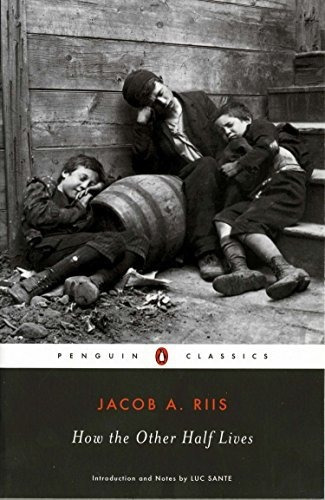Book : How The Other Half Lives Studies Among The Tenements
Cuota promocionada en 6 cuotas de
Disponible 15 días después de tu compra
MercadoLíder | +10mil ventas
MercadoLíder Platinum
+10mil
Ventas concretadas
Brinda buena atención
Medios de pago
Hasta 12 cuotas sin tarjeta
Tarjetas de crédito
Tarjetas de débito
Efectivo


Características del producto
Características principales
Título del libro | How The Other Half Lives Studies Among The Tenements Of New |
|---|---|
Autor | Jacob A. Riis |
Idioma | Inglés |
Editorial del libro | Penguin Classics |
Tapa del libro | Blanda |
Año de publicación | 1997 |
Marca | Penguin Classics |
Modelo | Ingles |
Otras características
Cantidad de páginas | 256 |
|---|---|
Tipo de narración | Novela |
Descripción
- ANTES DE COMPRAR PREGUNTE FECHA DE ENTREGA.
- ENVIAMOS POR MERCADOENVIOS
- PUEDE RETIRAR POR AHORA SOLO POR QUILMES, MICROCENTRO ESTA CERRADO, POR ESO...
- EN CABA (CAPITAL FEDERAL) ENVIAMOS SIN CARGO ESTE PRODUCTO.
- FORMA DE PAGO : MERCADOPAGO
- HACEMOS FACTURA A.
- ELBAZARDIGITAL VENDEDOR PLATINUM
- TODOS NUESTROS PRODUCTOS EN:
https://eshops.mercadolibre.com.ar/elbazardigital
-X-X-X-
- SOMOS IMPORTADORES DIRECTOS, ESTE PRODUCTO SE COMPRA Y SE IMPORTA DESDE ESTADOS UNIDOS, ESTO IMPLICA QUE USTED ESTA COMPRANDO EL MISMO PRODUCTO QUE COMPRARÍA UN CLIENTE DE ESE PAÍS.
- ANTES DE REALIZAR UNA CONSULTA, VISUALICE TODAS LAS IMAGENES DEL PRODUCTO.
Descripción provista por la editorial :
About the Author Jacob Riis (1849-1914) was a journalist and photographer born in Denmark.Luc Sante teaches writing and the history of photography at Bard College. His books include Low Life, Evidence, and The Factory of Facts. First published in 1890, Jacob Riiss remarkable study of the horrendous living conditions of the poor in New York City had an immediate and extraordinary impact on society, inspiring reforms that affected the lives of millions of people.For more than seventy years, Penguin has been the leading publisher of classic literature in the English-speaking world. With more than 1,700 titles, Penguin Classics represents a global bookshelf of the best works throughout history and across genres and disciplines. Readers trust the series to provide authoritative texts enhanced by introductions and notes by distinguished scholars and contemporary authors, as well as up-to-date translations by award-winning translators. Excerpt. © Reprinted by permission. All rights reserved. List of IllustrationsIntroduction by Luc SanteSuggestions for Further ReadingA Note on the TextHow the Other Half LivesPrefaceIntroduction1 Genesis of the Tenement2 The Awakening3 The Mixed Crowd4 The Down Town Back-alleys5 The Italian in New York6 The Bend7 A Raid on the Stale-beer Dives8 The Cheap Lodging-houses9 Chinatown10 Jewtown11 The Sweaters of Jewtown12 The Bohemians - Tenement-house Cigarmaking13 The Color Line in New York14 The Common Herd15 The Problem of the Children16 Waifs of the City’s Slums17 The Street Arab18 The Reign of Rum19 The Harvest of Tares20 The Working Girls of New York21 Pauperism in the Tenements22 The Wrecks and the Waste23 The Man with the Knife24 What Has Been Done25 How the Case StandsAppendixExplanatory NotesPENGUIN CLASSICSHOW THE OTHER HALF LIVESJacob A. Riis (1849-1914) was the first reformer to effectively convey to a wide public the unacceptable nature of living conditions endured by the urban poor. His use of the relatively new medium of photography brought an unprecedented power to his message.In 1870 Riis, born in Ribe, Denmark, arrived in New York as a Danish immigrant, one among thousands of the poor, friendless, and unskilled. Like so many, he frequently spent nights in police station lodging houses, the shelters of last resort in late nineteenth-century New York. He soon left the city to work at an assortment of rural jobs, but returned in 1877 to find steady employment as a police reporter for the Tribune (1877-88) and, later, the Evening Sun (1888-99). New York’s police headquarters was then on Mulberry Street, in the heart of the Lower East Side slum district. As Riis’s familiarity with the neighborhood’s squalid living conditions deepened, he began to employ his journalistic skills to convey his revulsion to the public.For ten years (1877-87) Riis wrote and lectured stressing his view that the poor were victims rather than makers of their fate, a concept then emerging among social reformers. However, despite his considerable rhetorical skills and instructional use of statistics, architectural plans, and maps, Riis was unable to communicate the elemental shock he felt on his nightly sorties through the worst slums. It was the 1887 invention of flash photography - which allowed photographs to be taken in the darkest tenements - that provided Riis with a powerful new resource. Initially employing amateur and professional photographers, and later on his own, Riis photographed the horrors of slum life specifically to shift prevailing public opinion from passive acceptance to a realization that such living conditions must be improved.Armed with this visual evidence, Riis added “magic lantern” slide shows to his lectures. Local newspapers reported that his viewers moaned, shuddered, fainted, even talked to the photographs he projected, reacting to the slides not as images but as a virtual reality that transported the New York slum world directly in
-o-o-o-
Garantía del vendedor: 90 días
Preguntas y respuestas
¿Qué querés saber?
Preguntale al vendedor
Nadie hizo preguntas todavía. ¡Hacé la primera!

